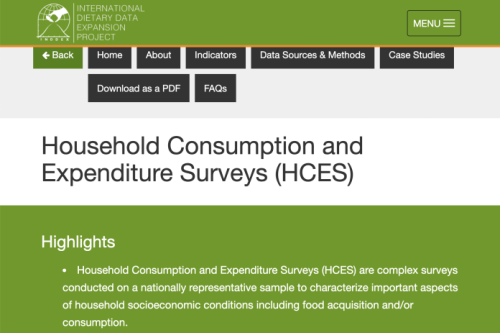HCESs collect data on household socio-economic conditions including food acquisition and consumption. Users can download data for analysis. Nutrient intake is referred to as “apparent intake” because household-level micronutrient supplies are distributed among household members in proportion to individual energy requirements. The HCES is also known as Living Standards Measurement Study (LSMS).
Time: Users need to download, clean, and analyze data. This could take a few weeks, depending on data quality and complexity of the analyses.
Human Resources: Requires expertise in nutrition, data cleaning, and statistical analysis.
Relative Cost: Low
Strengths: Data is routinely collected every 3–5 years. Representative at national, and in some cases, sub-national levels.
Limitations: Lack of data on intra-household food allocation can result in over- or under-estimation of apparent consumption. Some HCESs measure food acquisition, not actual consumption. Some HCESs do not collect data on foods consumed outside the home. Requires expertise and time to standardize quantities, match foods to food composition data, and analyze. Heterogeneous across countries, so some surveys may lack detail or not be comparable. Use requires more testing to validate.
Indicators
We found relevant indicators for 3 diet question(s) based on the filters below (or your answers to preceding questions). Use the filters to see other indicators by target group or diet question.
Target group: Women: 15–49 years of age (non-pregnant, non-lactating)
Is my target group consuming foods or food groups that provide adequate nutrients?
- Nutrient adequacy: Percentage of women of reproductive age (15–49 years) with adequate nutrient intake from foods.
- Nutrient intake: Mean/median nutrient intake among women of reproductive age (15–49 years).
Target group: Men
Is my target group consuming foods or food groups that provide adequate nutrients?
- Nutrient adequacy: Percentage of men in specified age range with adequate nutrient intake from food and/or supplements.
- Nutrient intake: Mean/median nutrient intake among men in specified age range.
What foods or food groups is my target group consuming?
- Food consumption—healthy: Percentage of men in a specified age range who consumed healthy foods, beverages, and/or food groups during the previous day (e.g., user-defined healthy food, beverage, or food group; or Diet Quality-Questionnaire (DQ-Q) defined groups).
- Food consumption—amount: Mean/median amount of a healthy food, beverage, or food group consumed by men in specified age range during the previous day.



